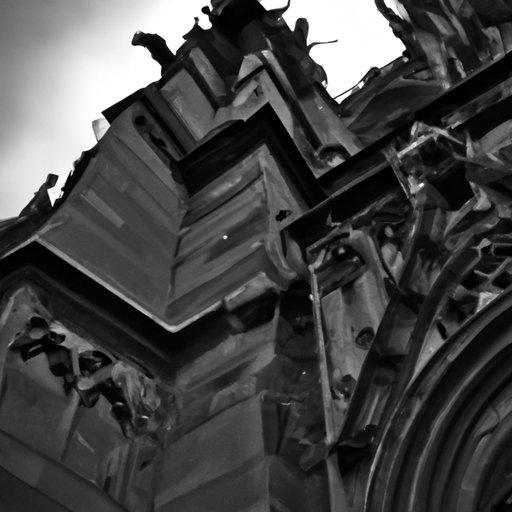Introduction
Gothic architecture is a style of design that was popular during the medieval period in Europe. Characterized by pointed arches, ribbed vaults, flying buttresses, and stained glass windows, Gothic architecture is renowned for its grandeur and beauty. From the iconic Notre Dame Cathedral in Paris to Westminster Abbey in London, this architectural style has left an indelible mark on some of the most famous buildings in the world.
Exploring the Iconic Features of Gothic Architecture
The defining feature of Gothic architecture is the pointed arch. This type of arch allowed for higher ceilings and thinner walls than those found in earlier Romanesque designs. Pointed arches were often used in vaulting, which served to strengthen structures and add to the overall aesthetic appeal of the building.
Another distinctive element of Gothic architecture are the flying buttresses. These external supports helped to distribute the weight of the roof and walls, allowing for larger windows and more intricate designs. Flying buttresses also provided additional stability for the structure, allowing for taller spires and steeples.
Ribbed vaults were also a common feature of Gothic architecture. These vaults featured intersecting arches that created an intricate network of ribs throughout the ceiling. Ribbed vaults provided additional support to the structure while also creating a visually stunning effect.
Stained glass windows were also integral to Gothic architecture. These colorful and ornate windows allowed light to enter the building while also adding to its overall beauty. Many of these windows depicted religious scenes or figures, providing insight into the beliefs and values of the time.

A Look at the Masterpieces of Gothic Architecture
One of the most iconic examples of Gothic architecture is Notre Dame Cathedral in Paris, France. Built in the 12th century, this iconic structure is renowned for its intricate carvings, grand spire, and ornate stained glass windows. The cathedral has remained a symbol of the city for centuries, making it one of the most recognizable examples of Gothic architecture in the world.
Another masterpiece of Gothic architecture is Westminster Abbey in London, England. Built in the 13th century, the abbey is known for its exquisite sculptures, stained glass windows, and intricate vaulting. The abbey also serves as the resting place of many English kings and queens, making it a historically significant site.
Salisbury Cathedral in Salisbury, England is also a renowned example of Gothic architecture. Built in the early 13th century, the cathedral is renowned for its soaring spire, elaborate tracery, and beautiful stained glass windows. It is also home to the oldest working clock in the world, making it a truly unique site.

The Rise of Gothic Architecture Across Europe
Gothic architecture began to take shape in France during the 12th century. The style spread quickly throughout the country, with churches and cathedrals being constructed in the Gothic style. Gothic architecture also gained popularity in England in the 13th century, with many churches, cathedrals, and universities being built in the style. In Germany, Gothic architecture took hold during the 14th century, with many castles and cathedrals being constructed in the style.
Investigating the Influences of Gothic Architecture
Gothic architecture drew inspiration from a variety of sources, including Roman architecture, Islamic architecture, and early Christian architecture. In particular, the use of pointed arches was heavily influenced by Roman architecture, while the use of ribbed vaults was inspired by Islamic architecture. Early Christian architecture also played a role in the development of Gothic architecture, with many churches and cathedrals incorporating elements such as stained glass windows and soaring spires.

Examining the Impact of Gothic Architecture on Society Today
Gothic architecture has had a lasting impact on society today. The preservation of historic sites such as Notre Dame Cathedral and Westminster Abbey has provided insight into the culture and values of past civilizations. Additionally, the intricate designs and ornate features of Gothic architecture have served as inspiration for modern architects and designers. Finally, Gothic architecture has a deep cultural significance, with many people around the world viewing it as a symbol of beauty and grandeur.
Conclusion
Gothic architecture is a beloved style of design that has been around for centuries. With its distinct features such as pointed arches, ribbed vaults, and stained glass windows, Gothic architecture has left its mark on some of the most iconic buildings in the world. Its influences on Roman, Islamic, and early Christian architecture have also contributed to its lasting impact on society today. From preservation of historic sites to inspiration for contemporary design, Gothic architecture has made an indelible mark on the world.
(Note: Is this article not meeting your expectations? Do you have knowledge or insights to share? Unlock new opportunities and expand your reach by joining our authors team. Click Registration to join us and share your expertise with our readers.)
